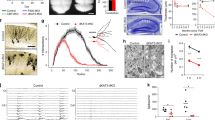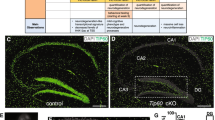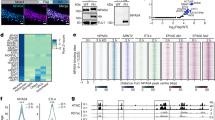Abstract
Brain-derived neurotrophic factor (BDNF) and other neurotrophins have a vital role in the development of the rat and mouse nervous system by influencing the expression of many specific genes that promote differentiation, cell survival, synapse formation and, later, synaptic plasticity1. Although nitric oxide (NO) is known to be an important mediator of BDNF signalling in neurons2, the mechanisms by which neurotrophins influence gene expression during development and plasticity remain largely unknown. Here we show that BDNF triggers NO synthesis and S-nitrosylation of histone deacetylase 2 (HDAC2) in neurons, resulting in changes to histone modifications and gene activation. S-nitrosylation of HDAC2 occurs at Cys 262 and Cys 274 and does not affect deacetylase activity. In contrast, nitrosylation of HDAC2 induces its release from chromatin, which increases acetylation of histones surrounding neurotrophin-dependent gene promoters and promotes transcription. Notably, nitrosylation of HDAC2 in embryonic cortical neurons regulates dendritic growth and branching, possibly by the activation of CREB (cyclic-AMP-responsive-element-binding protein)-dependent genes. Thus, by stimulating NO production and S-nitrosylation of HDAC2, neurotrophic factors promote chromatin remodelling and the activation of genes that are associated with neuronal development.
This is a preview of subscription content, access via your institution
Access options
Subscribe to this journal
Receive 51 print issues and online access
$199.00 per year
only $3.90 per issue
Buy this article
- Purchase on Springer Link
- Instant access to full article PDF
Prices may be subject to local taxes which are calculated during checkout




Similar content being viewed by others
References
Huang, E. & Reichardt, L. Neurotrophins: roles in neuronal development and function. Annu. Rev. Neurosci. 24, 677–736 (2001)
Riccio, A. et al. A nitric oxide signaling pathway controls CREB-mediated gene expression in neurons. Mol. Cell 21, 283–294 (2006)
Reik, W. Stability and flexibility of epigenetic gene regulation in mammalian development. Nature 447, 425–432 (2007)
Kouzarides, T. Chromatin modifications and their function. Cell 128, 693–705 (2007)
Huang, E. J. & Reichardt, L. F. Trk receptors: roles in neuronal signal transduction. Annu. Rev. Biochem. 72, 609–642 (2003)
Zweifel, L. S., Kuruvilla, R. & Ginty, D. D. Functions and mechanisms of retrograde neurotrophin signalling. Nature Rev. Neurosci. 6, 615–625 (2005)
Zhang, J. & Snyder, S. H. Nitric oxide in the nervous system. Annu. Rev. Pharmacol. Toxicol. 35, 213–233 (1995)
Boehning, D. & Snyder, S. H. Novel neural modulators. Annu. Rev. Neurosci. 26, 105–131 (2003)
Stamler, J. S., Lamas, S. & Fang, F. C. Nitrosylation. the prototypic redox-based signaling mechanism. Cell 106, 675–683 (2001)
Hess, D. T., Matsumoto, A., Kim, S. O., Marshall, H. E. & Stamler, J. S. Protein S-nitrosylation: purview and parameters. Nature Rev. Mol. Cell Biol. 6, 150–166 (2005)
Marshall, H. E., Hess, D. T. & Stamler, J. S. S-nitrosylation: Physiological regulation of NF-κB. Proc. Natl Acad. Sci. USA 101, 8841–8842 (2004)
Stroissnigg, H. et al. S-nitrosylation of microtubule-associated protein 1B mediates nitric-oxide-induced axon retraction. Nature Cell Biol. 9, 1035–1045 (2007)
Jaffrey, S. R. & Snyder, S. H. The biotin switch method for the detection of S-nitrosylated proteins. Sci. STKE 2001, PL1 (2001)
Forrester, M. T., Foster, M. W. & Stamler, J. S. Assessment and application of the biotin switch technique for examining protein S-nitrosylation under conditions of pharmacologically induced oxidative stress. J. Biol. Chem. 282, 13977–13983 (2007)
Whalen, E. J. et al. Regulation of β-adrenergic receptor signaling by S-nitrosylation of G-protein-coupled receptor kinase 2. Cell 129, 511–522 (2007)
Uehara, T. et al. S-Nitrosylated protein-disulphide isomerase links protein misfolding to neurodegeneration. Nature 441, 513–517 (2006)
Hara, M. R. et al. S-nitrosylated GAPDH initiates apoptotic cell death by nuclear translocation following Siah1 binding. Nature Cell Biol. 7, 665–674 (2005)
Hausladen, A., Privalle, C. T., Keng, T., DeAngelo, J. & Stamler, J. S. Nitrosative stress: activation of the transcription factor OxyR. Cell 86, 719–729 (1996)
Cheung, P., Allis, C. D. & Sassone-Corsi, P. Signaling to chromatin through histone modifications. Cell 103, 263–271 (2000)
Berger, S. L. The complex language of chromatin regulation during transcription. Nature 447, 407–412 (2007)
Wink, D. A. et al. Detection of S-nitrosothiols by fluorometric and colorimetric methods. Methods Enzymol. 301, 201–211 (1999)
Haendeler, J. et al. Redox regulatory and anti-apoptotic functions of thioredoxin depend on S-nitrosylation at cysteine 69. Nature Cell Biol. 4, 743–749 (2002)
Hassig, C. A. et al. A role for histone deacetylase activity in HDAC1-mediated transcriptional repression. Proc. Natl Acad. Sci. USA 95, 3519–3524 (1998)
Gu, Z. et al. S-nitrosylation of matrix metalloproteinases: signaling pathway to neuronal cell death. Science 297, 1186–1190 (2002)
Mustafa, A. K. et al. Nitric oxide S-nitrosylates serine racemase, mediating feedback inhibition of d-serine formation. Proc. Natl Acad. Sci. USA 104, 2950–2955 (2007)
Huang, Y. et al. S-nitrosylation of N-ethylmaleimide sensitive factor mediates surface expression of AMPA receptors. Neuron 46, 533–540 (2005)
Redmond, L., Kashani, A. H. & Ghosh, A. Calcium regulation of dendritic growth via CaM kinase IV and CREB-mediated transcription. Neuron 34, 999–1010 (2002)
Bredt, D. S. & Snyder, S. H. Transient nitric oxide synthase neurons in embryonic cerebral cortical plate, sensory ganglia, and olfactory epithelium. Neuron 13, 301–313 (1994)
Fischer, A., Sananbenesi, F., Wang, X., Dobbin, M. & Tsai, L. H. Recovery of learning and memory is associated with chromatin remodelling. Nature 447, 178–182 (2007)
Mallis, R. J., Buss, J. E. & Thomas, J. A. Oxidative modification of H-ras: S-thiolation and S-nitrosylation of reactive cysteines. Biochem. J. 355, 145–153 (2001)
Huang, P. L., Dawson, T. M., Bredt, D. S., Snyder, S. H. & Fishman, M. C. Targeted disruption of the neuronal nitric oxide synthase gene. Cell 75, 1273–1286 (1993)
Laherty, C. D. et al. Histone deacetylases associated with the mSin3 corepressor mediate mad transcriptional repression. Cell 89, 349–356 (1997)
Wegener, D., Wirsching, F., Riester, D. & Schwienhorst, A. A fluorogenic histone deacetylase assay well suited for high-throughput activity screening. Chem. Biol. 10, 61–68 (2003)
Acknowledgements
We are grateful to D. D. Ginty, A. Lloyd, M. Raff and A. Saiardi for comments and to all members of the Riccio laboratory for discussion. We thank E. Seto for providing HDAC plasmids and A. Chittka for help with the purification of recombinant HDAC2. We also thank C. Andreassi for help with cell lines and molecular biology techniques. This work was supported by the Medical Research Council (MRC; grant G0500792), and the European Research Council (Marie Curie International Reintegration grant MIRG-CT-2005-016501). A.R. is a recipient of an MRC Career Development Fellowship (G117/533) and P.M.W. of an MRC Career Development Award.
Author Contributions A.N. performed most of the experiments, analysed the data and helped to write the manuscript. P.M.W. performed the HDAC activity assay and some of the biotin-switch and ChIP assays. J.D.R. provided the DAF-FM DA data and contributed to the analysis of dendritic growth. L.C. designed and tested the siRNAs and helped with the HDAC2 constructs. A.R., the senior author, designed the project, performed most of the ChIP assays, analysed the data, wrote the manuscript and provided financial support.
Author information
Authors and Affiliations
Corresponding author
Supplementary information
Supplementary Information
This file contains Supplementary Figures S1-S7 and legends. (PDF 12388 kb)
Rights and permissions
About this article
Cite this article
Nott, A., Watson, P., Robinson, J. et al. S-nitrosylation of histone deacetylase 2 induces chromatin remodelling in neurons. Nature 455, 411–415 (2008). https://doi.org/10.1038/nature07238
Received:
Accepted:
Published:
Issue Date:
DOI: https://doi.org/10.1038/nature07238
This article is cited by
-
Activation of β2-adrenergic receptors prevents AD-type synaptotoxicity via epigenetic mechanisms
Molecular Psychiatry (2023)
-
Pivotal role for S-nitrosylation of DNA methyltransferase 3B in epigenetic regulation of tumorigenesis
Nature Communications (2023)
-
Efficient gene delivery into the embryonic chicken brain using neuron-specific promoters and in ovo electroporation
BMC Biotechnology (2022)
-
Hydrogen peroxide-induced stress acclimation in plants
Cellular and Molecular Life Sciences (2022)
-
Contribution of histone acetylation to the serotonin-mediated long-term synaptic plasticity in terrestrial snails
Journal of Comparative Physiology A (2022)
Comments
By submitting a comment you agree to abide by our Terms and Community Guidelines. If you find something abusive or that does not comply with our terms or guidelines please flag it as inappropriate.



